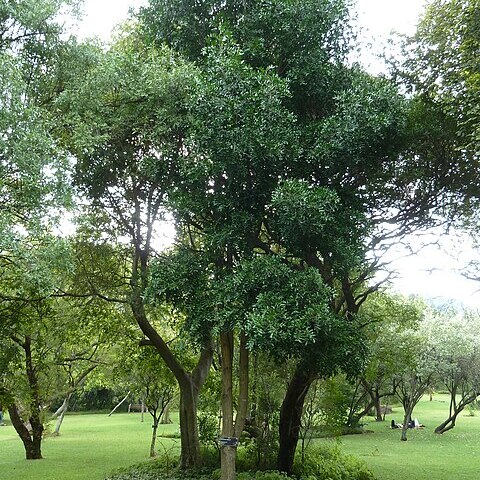Shrub or tree usually less than 15 m tall, occasionally up to 20 m or more, usually deciduous; bole up to 1 m or more in diameter. Bark whitish grey, smooth at first, later darker and with longitudinal fissures. Leaves up to 120 mm long; rhachis slightly winged, usually ending in a short appendage. Leaflets usually in 3-7 pairs, up to 50 x 24 mm, very asymmetric, apex obtuse, rounded or emarginate, rarely acute or mucronate; secondary nerves rather close together, prominent on both surfaces. Inflorescence up to 50 mm long, axillary or in axils of fallen leaves. Flowers pale yellow, usually appearing before or with the young leaves. Calyx 1 mm long, sparsely puberulous; lobes acute. Petals 5 x 1.5 mm, glabrous except for the ciliolate margin. Stamens 3.5 mm long; staminodes 2 mm long; antherodes minute. Ovary 1.75 mm long, style about 1.25 mm long; pistillode minute, embedded in the disc, sometimes with 2 vestigial styles and loculi. Capsule chestnut-brown with conspicuous veins, c. 18 x 12 mm. Seed c. 16 x 6 mm.
Tree or shrub, often aromatic, dioecious, with indistinct oil cavities in younger parts. Leaves opposite or subopposite, paripinnate; rachis slightly winged; leaflets asymmetrical, opposite; stipules absent. Flowers unisexual, regular, in contracted thyrses, pale yellow. Sepals 4, variously connate or almost free; lobes imbricate or with open aestivation. Petals 4, free, valvate or imbricate. Disc annular, intra-staminal, fleshy. Male flowers: stamens 4, arising at base of disc; ovary absent. Female flowers: staminodes rudimentary; ovary superior, arising on disc, 2-locular, with a solitary ovule in each locule; styles 2, free or connate; stigmas capitate. Flowering time all year. Fruit a compressed capsule, bilobed from apex, cordate at base, 2-locular, 2-seeded, dehiscing along an inner suture, eventually suspended from bipartite axis. Seeds compressed, with a terminal wing.
Leaves densely puberulous when young, the hairs sometimes persisting on the petiole and rhachis and less densely so on the lamina; rhachis (+ petiole) up to 12 cm. long, flattened and slightly winged, usually ending in a short appendage; leaflets 3–7-jugate, subsessile, opposite, rarely subopposite, exceptionally alternate, leaflet-lamina up to 5 × 2·4 cm., usually much smaller, very asymmetric, apex obtuse, rounded or emarginate, rarely mucronate, base cuneate, secondary nerves rather close together, prominent on both surfaces.
A shrub or small tree. It grows 15 m tall. The trunk is 30 cm across. The leaves have 3-7 pairs of leaflets. These are 5 cm long by 2.4 cm wide. Young leaves are hairy. The flowers are yellow and in groups in the axils of leaves. The fruit is a capsule that splits into 2 valves. It is 18 mm long by 12 mm wide. The seeds is 16 mm long by 6 mm wide.
Shrub or tree, usually not taller than 15 m. Leaflets in 3-7 pairs, up to 50 x 24 mm, very asymmetric. Fruit a capsule, splitting into 2 persistent, bilobed valves, chestnut-brown with conspicuous veins. Flowers pale yellow.
Shrub or small to medium-sized tree up to 15 m. tall, usually deciduous; bole up to 0·3 m. in diam. at breast height, rarely more; bark whitish-grey and smooth at first, later darker with longitudinal fissures.
Dioecious, deciduous shrub or tree rarely to 20 m. Leaves opposite, paripinnate, leaflets in 3-7 pairs, oblique. Flowers in axillary thyrses, pale yellow.
Ovary c. 1·75 mm. long, style about 1·25 mm. long; pistillode minute, embedded in the disk, sometimes with two vestigial styles and loculi.
Inflorescence up to 5 cm. long, axillary or in the axils of fallen leaves.
Flowers pale yellow, usually appearing before or with the new leaves.
Stamens c. 3·5 mm. long; staminodes c. 2 mm.; antherodes minute.
Petals c. 5 × 1·5 mm., glabrous except for the ciliolate margin.
Capsule chestnut-brown with conspicuous veins, c. 18 × 12 mm.
Calyx c. 1 mm. long, sparsely puberulous; lobes acute.
Seed c. 16 × 6 mm.


